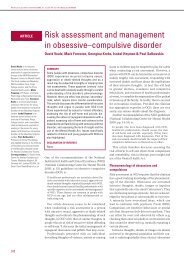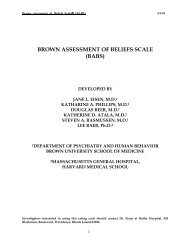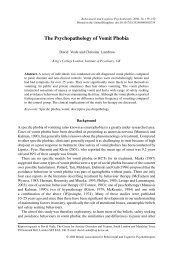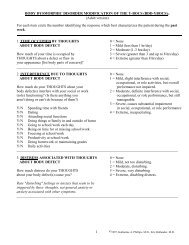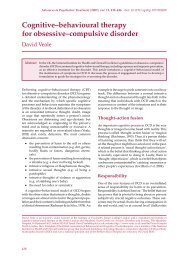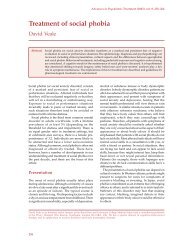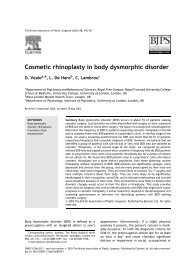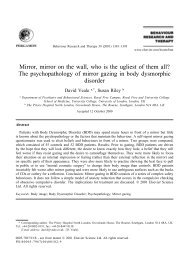Download - Dr David Veale
Download - Dr David Veale
Download - Dr David Veale
You also want an ePaper? Increase the reach of your titles
YUMPU automatically turns print PDFs into web optimized ePapers that Google loves.
Ada Psychiatr Scand 2000: 101: 80-82Printed in UK. AU rights reservedCopyright © Munksgaard 2000ACTA PSYCHIATRtCASCANDtNA VIC AISSN 0902-4441Case report'Everybody looks at my pubic bone' — a casereport of an adolescent patient with bodydysmorphic disorderSobanski E, Schmidt MH. 'Everybody looks at my pubic bone' — a casereport of an adolescent patient with body dysmorphic disorder.Acta Psychiatr Scand 2000: 101: 80-82. © Munksgaard 2000.Objective: Body dysmorphic disorder (BDD) was described for the firsttime more than 100 years ago, but it is still unknown to many clinicians.Although the onset usually occurs during adolescence, BDD has receivedlittle attention in the adolescent psychiatric literature.Method: The case and treatment of a 16-year-old female patient isdescribed.Results: The patient, suffering from the overvalued belief of a dislocatedpubic bone, a comorbid mild depressive episode, BDD associated ritualsand social avoidance, was treated successfully with a combination ofexposure and response prevention and 125 mg/day of doxepine.Conclusion: If BDD is diagnosed early in the course and treatedappropriately, it is possible to obtain a satisfying outcome.E. Sobanski, M. H. SchmidtDepartment of Child and Adolescent Psychiatry,Central Institute of Mental Health,D-68072 Mannheim, GermanyKey words: body dysmorphic disorder; depression;behavioral therapy; somatoform disordersE. Sobanski MD, Department of Child and AdolescentPsychiatry, Central Institute of Mental Health,D-68072 Mannheim, POB 122 129,D-68072 Mannheim, GermanyAccepted for publication September 9, 1999IntroductionBody dysmorphic disorder is characterized by anexcessive preoccupation with a real minor orimagined defect in physical appearance. Thepatients' degree of insight into the exaggeratednature of their dysmorphophobic concerns variesfrom obsessive thoughts with good insight, andovervalued ideas to delusions where insight isabsent. The onset of symptoms usually occursduring adolescence and the course tends to bechronic without appropriate treatment.Case reportThe 16-year-old girl had been suffering for about 6months from the belief that her pubic bone wasbecoming increasingly dislocated and prominent,such that everyone would stare at and talk about it.The girl could not remember a particular occurrencewhich had brought on the symptom and had noinsight into its psychological nature. She was totallyconvinced that she could only be helped by asurgical correction of her pubic bone. In an attemptto achieve a smaller hip girth and also to influencethe pubic bone she had reduced her body weightfrom 48 kg to 44 kg with a height of 1.68 m, whichcorresponds to a body mass index (BMI) of 15.8 kg/m^. The weight reduction led to amenorrhoea. Onemonth before admission to our clinic she wasadmitted to a paediatric clinic where anorexianervosa was diagnosed. She was fed with highcaloricnutrient solution and gained 2 kg. Twoweeks before the referral to our clinic the girl hadbecome totally housebound because she wasextremely ashamed of her looks. She spent almostthe entire day in her bedroom, wearing excessivelylarge pyjamas. At admission her mood was depressedand her drive reduced. She cried often andreported anhedonia, hopelessness and loss ofinterest. She denied suicide ideation. Up to 10times a day she lowered herself to the ground andmeasured, with her fingers, the distance between herpelvic girdle and the soil in order to check theposition of her pubic bone. She was constantlypreoccupied with thoughts about it.The girl was the eldest daughter of a couple withuniversity education, and had a 5-year-old sister.80
Case report of a patient with body dysmorphic disorderNo particular problems in family interaction couldbe assessed and there was no family history forpsychiatric disorders. Pregnancy and early developmentoccurred without problems. She wasdescribed by her parents as being ambitious atschool and a little reserved and shy towards herpeers, with no long-term close friendships but withregular dates with her classmates. She had dated for1 month with a boy of her age, but had discontinuedthe relationship because she felt too occupied by it.She had no previous sexual experience.The patient was treated for 10 weeks at our clinic.She was obliged to gain 2 kg weight, receiving fromthe second week onwards 125 mg/day of doxepineand therapy with exposure and response prevention.We first set up an anxiety hierarchy of avoidedsituations with raising degree of difficulty: 1,wearing jeans in her own room; 2, wearing jeansin the ward and meeting others; 3, wearing jeans,going to town and visiting a pub; and 4, visiting herschool and meeting classmates. She was treated withthree sessions of 60-90 min per week. At first shewas extremely upset by the training programme andhad thoughts such as: '1 am an outsider. Everybodylooks at my pubic bone. If it would be normal,everything would be fine, I need a surgicalcorrection,' Gradually it became easier for her toface formerly avoided situations. At the end oftreatment, the girl's BDD symptoms were distinctlyimproved. Despite her still being certain about thedislocation of her pubic bone, the belief was lessdistressing for her and no longer impaired her dailylife. She had stopped camouflaging and checkingher pubic bone. She dated with her peers andattended school regularly; the depressive symptomshad completely vanished. When she was seen after 6months for follow-up the therapeutic results hadremained stable.DiscussionPatients with BDD do not consult mental healthprofessionals primarily because of the somaticexplanation of their concerns, seeking treatmentby general practitioners, dermatologists, dentistsand plastic surgeons, resulting in low prevalence inclinical psychiatric populations. To date there hasbeen little research concerning BDD, Two crosssectionalsurveys were carried out 1993 in theUnited States by Phillips et al, (1) and 1996 in theUnited Kingdom by <strong>Veale</strong> et al, (2), One epidemiologicalsurvey was carried out 1997 in Italy byFaravelli et al, (3), who reported a 1-year prevalenceof BDD of 0,7%, In terms of adolescents there havebeen only a few case studies (4, 5), and no largersurveys at all.Besides BDD the patient described in the casereport suffered from typical comorbid features,namely a mild depressive episode (ICD-10: 7^32,0),associated rituals and social avoidance. Accordingto the scientific literature depression is the mostfrequently related psychiatric disorder. Between60% and 94% of patients with BDD have a lifetimediagnosis of depression (1,2), Most individuals withBDD perform ritualistic behaviours related to theirdysmorphophobic beliefs that resemble obsessivecompulsivedisorder (OCD) compulsions. Between6% and 30% fulfil the diagnostic criteria for aconcurrent OCD (1, 2, 6), Virtually always, BD<strong>Dr</strong>esults in social impairment, in particular avoidanceof social interactions. Available studies showa percentage for social phobia in BDD patientsvarying between 10% and 43% (1,2, 7), In a series of100 patients, 32 had been completely houseboundfor at least 1 year (6). Despite the low BMI of 15.8kg/m^ and the amenorrhoea the patient describeddid not suffer from anorexia nervosa, because othercore symptoms such as weight phobia and disturbanceof the whole-body image were not present.The dysmorphophobic symptoms were treatedsuccessfully with exposure and response prevention.At the end of treatment the girl's social andoccupational functioning had improved distinctly.Several studies published in recent years report thatup to 70% of patients with BDD benefit fromsystematic exposure to avoided situations andprevention of anxiety-reducing behaviours (8, 9),Although there is growing evidence that BDDsymptoms, as well as comorbid depression, respondpreferentially to SSRIs the comorbid depressivesymptoms of our patient were treated with doxepine,because no data are available concerning theuse of SSRIs in adolescents for this condition.The case report shows that it is possible to obtaina satisfying outcome if BDD is diagnosed early andtreated appropriately. Severe complications such asbeing housebound, or suicide attempts, which occurin up to 25% (10), can thereby be avoided. Therefore,it is necessary that more clinicans are informedabout the disorder. More scientific data are neededconcerning epidemiology, aetiology and treatmentstrategies.References1. PHILLIPS KA, MCELROY S, KECK PE, POPE HG, HUDSON JI.Body dysmorphic disorder: 30 cases of imagined ugliness.Am J Psychiatry 1993;150:302-308.2. VEALE D, BOOCKOK A, GOURNAY K et al. Body DysmorphicDisorder, a survey of fifty cases. Br J Psychiatry 1996;169:196-201.3. FARAVELLI C, SALVATORI S, GALASSI F, AIAZZI L, DREI C,CABRA S. Epidemiology of somatoform disorders: a81
Sobanski and Schmidtcommunity survey in Florence. Soc Psychiatr PsychiatrEpidemiol 1997;32:24-29.4. BRADDOCK LE. Dysmorphophobia in adolescence; a casereport. Br J Psychiatry 1982;140:199-201.5. PHILLIPS KA, ATALA K., ALBERTINE RS. Case study: bodydysmorphic disorder in adolescents. J Am Child AdolPsyhciatry 1995;9:1216-1220.6. PHILLIPS KA, MCELROY S, KECK P, HUDSON JI, POPE G. Acomparison of delusional and nondelusional body dysmorphicdisorder in 100 cases. Psychopharmacol Bull 1994;2:179-186.7. HOLLANDER E, COHEN LJ, SIMEON D. Body dysmorphicdisorder. Psychiatr Ann 1993;23:359-364.8. GOMEZ-PEREZ JC, MARKS IM, GUIRREZ-FISSAC JL.Dysmorphophobia: clinical features and outcome withbehavior therapy. Behav Psychiatr 1994;9:229-235.9. MCKAY D, TODARO J, NEZIROGLU F, CAMPISI T, MORITZEK, YARYURA-TOBIAS JA. Body dysmorphic disorder: apreliminary evaluation of treatment and maintenance usingexposure with response prevention. Behav Res Ther 1997;35:67-70.10. PHILLIPS KA. The broken mirror: understanding andtreating body dysmorphic disorder. New York: OxfordUniversity Press, 1996.Invited commentThis case is a useful addition to the literature onbody dysmorphic disorder (BDD), which remainsunder-researched and often difficult to treat. Thelocation of the perceived defect in her pubic bone isunusual, as most patients are usually preoccupiedwith some aspect of their face and have multipleperceived defects. The patient reported no particularreason for focusing on her pubic bone and onewould have thought that dieting would probablyhave made her pubic bone more prominent.The onset of BDD usually occurs duringadolescence, when individuals are at the most sensitiveabout their appearance and may be teased orbullied. However, most patients take up to 10-15years before they seek help from a mental healthprofessional and even then may present withsymptoms of depression or social phobia^ as theyare too ashamed to reveal their true problem. BDDis at the stage of public awareness and research asOCD in the 1970s and further publicity willhopefully lead to earlier referrals and appropriatetreatment. Too many patients are still being treatedwith pimozide and antipsychotic drugs, for whichthere is little efficacy. In this case, the authorstreated the patient successfully with a standardprogramme of behaviour therapy, namely exposureand response prevention (E&RP) in combinationwith doxepine. The engagement of a patient in apsychological understanding of the problem and thetreatment rationale is crucial. In this respect,patients may be recommended to read The BrokenMirror by Katherine Phillips (2). E&RP may be lesssuccessful in those patients who are more concernedwith an internal aversion towards their appearanceas opposed to an external fear of negative evaluationof others. Such patients may require a morecognitive approach, with identification of theircore beliefs about their appearance and the use ofrational role-plays and behavioural experiments (3).As the authors state, the pharmacological treatmentof choice in BDD is an SSRI, for which high dosesmay be required for a prolonged period of time.Doxepin has a moderate serotonin reuptake inhibitionand low noradrenergic reuptake inhibition.SSRIs are used for adolescents in OCD and couldbe safely justified if the patient had not responded.No data exist on whether CBT and an SSRIenhances efficacy especially when then there is acormorbid depression, but this is the best currentpragmatic approach. There remain a core group ofpatients who are very difficult to treat, who are ahigh suicide risk and who have a very poor qualityof life. Further research is required on thepsychopathology of BDD and randomized controlledtrials on CBT and SSRIs.References<strong>David</strong> <strong>Veale</strong>, Consultant PsychiatristGrovelands Priory HospitalThe Bourne, SouthgateLondon NM 6RA& Hon Senior LecturerRoyal Free Hospital School of MedicineUK1. SOBANSKI E, SCHMIDT MH. 'Everybody looks at my pubicbone' — a case report of a patient m\.\\ body dysmorphicdisorder. Acta Psychiatr Scand 2000; 101:80-82.2. PHILIPS K. The broken mirror: understanding and treatingbody dysmorphic disorder. New York: Oxford UniversityPress, 1996.3. VEALE D, GOURNAY K, DRYDEN W et al. Body dysmorphicdisorder: a cognitive behavioural model and pilot randomisedcontrolled trial. Behav Res Ther 1996;34:7l7-729.82



